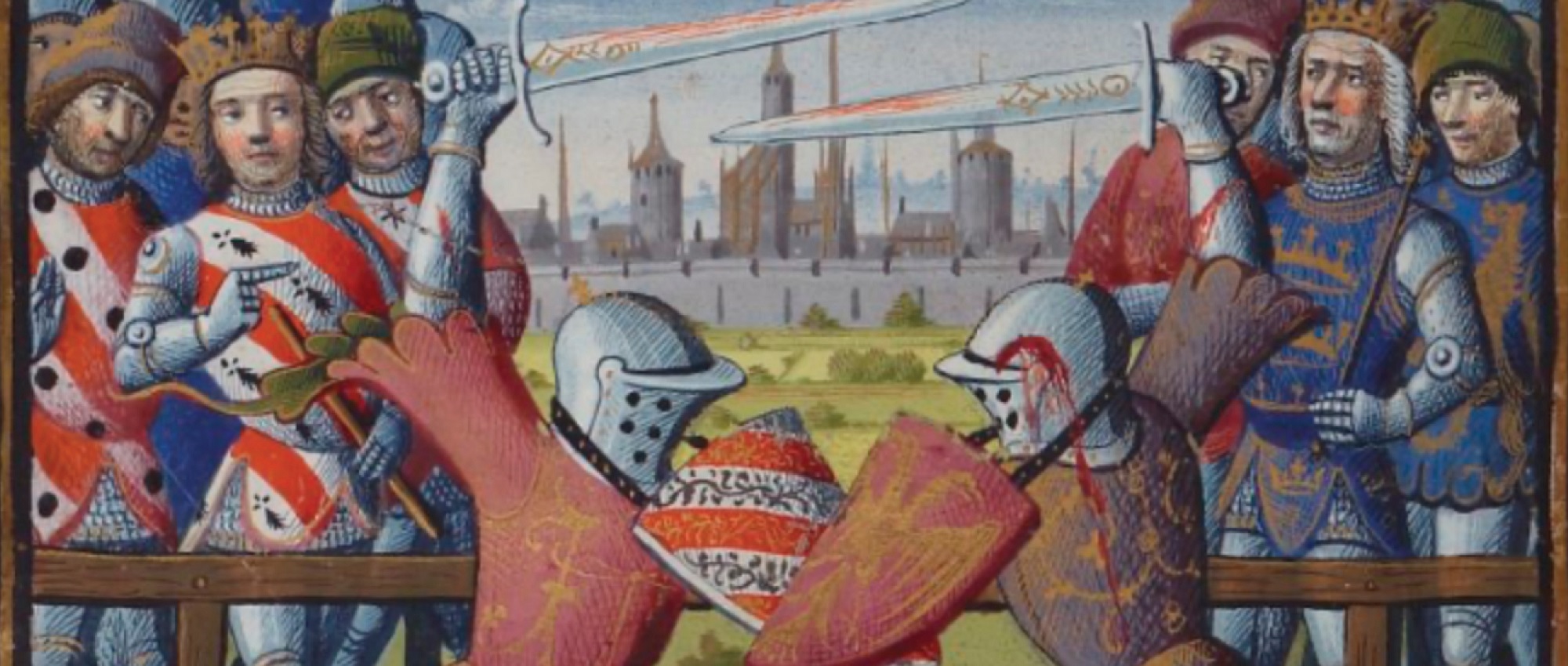Dr. Patrick Moran, Associate Professor of French, describes the process of translating Jean Frappier’s version of La Mort le roi Artu from Old to Modern French, and the overall significance of this medieval text.


Gawain and Lancelot in combat (Paris, Bibliothèque nationale de France, fr. 120, f° 590v, c. 1400)
“I couldn’t have been happier for the opportunity to translate what is probably my favourite Arthurian romance—maybe my favourite work of medieval literature altogether.”
I was approached to translate Jean Frappier’s version of La Mort le roi Artu from Old French to Modern French because of my work on the Vulgate Cycle and the 13th-century prose romances, and I couldn’t have been happier for the opportunity to translate what is probably my favourite Arthurian romance—maybe my favourite work of medieval literature altogether.
La Mort le roi Artu is the story of a world in disarray, where “the best lack all conviction, while the worst are full of passionate intensity” – to quote Yeats – and bad faith actors capitalize on people’s worst impulses to slowly replace the rule of law with brute force. It’s hard to understate how relevant this text is today.
Jean Frappier’s work is still the authoritative modern edition of La Mort le roi Artu, despite its age. It was the first edition to take into account all known manuscripts of the romance and to present a comprehensive vision of the medieval textual tradition. As a reconstructionist edition, it attempts to deduce the “original” text from its multiple manuscript copies. Frappier’s work was innovative and ground-breaking, and it made sense to update it for a new generation of readers with a brand new French translation.
From Old to Modern French


Guinevere laments Arthur’s pursuit of Lancelot (Paris, Bibliothèque nationale de France, fr. 116, f° 712r, c. 1475)
“My efforts focused on making the text feel more like a modern narrative, with streamlined sentence structures, snappier dialogue and more varied use of punctuation.”
Bilingual editions of medieval texts are a great way to reach audiences that might be intimidated by the intricacies of Old French, while still giving them the opportunity to read the original next to the translation. Modern French and Old French are the same language with just a few centuries’ difference, so one of the greatest perils when translating a medieval text is staying too close to the original: using the same syntax, the same rhythms, the same word order, and so on. Medieval prose feels clunky to 21st-century readers, because it was designed to be read out loud to a group, rather than silently and individually: the grammatical signposting is more obvious and relies more on redundancy and repetition.
A lot of my efforts focused on making the text feel more like a modern narrative, with streamlined sentence structures, snappier dialogue and a more varied use of punctuation. My own work as novelist probably helped me view the text in a slightly different light from other translators. It was an interesting experiment, since I didn’t want to stray too far from the original text and obfuscate the author’s voice either; it was all about preserving the deep structure of the text while updating its surface delivery.
Significance


Battle of Salisbury between Arthur and Mordred (Paris, Bibliothèque nationale de France, fr. 112, f° 226r, c. 1470)
“La Mort le roi Artu (The Death of King Arthur in Old French) is one of the most important works of Arthurian literature.”
The early 13th century was a period of great upheaval in the history of romance as a genre. The first French-language romances in the 12th century were all written in verse, but around 1200, a number of authors decided to experiment with prose, and basically invented what would become the modern novel: a lengthy fictional prose narrative that explores the personal and social transformations of a certain number of characters in a changing environment. La Mort le roi Artu was one of the first of these prose romances.
It is the last part of a hugely popular cycle known as the Lancelot-Grail or Vulgate Cycle, which revolutionized the way authors wrote about King Arthur and the adventures of his Knights of the Round Table. Up until the early 1200s, Arthurian romances in Old French were relatively short and concentrated on the adventures of one or two knights. The Vulgate Cycle introduced a historical perspective and chose to focus on the collective story of Arthur’s realm, weaving and intertwining dozens of tales into a multilayered narrative. The six-romance cycle covers thousands of pages in modern editions, and goes from the origins of the Grail and the birth of Arthur all the way to the fall of his kingdom.
This ambitious multi-generational chronicle was a huge success throughout the Middle Ages and influenced Thomas Malory’s English-language Morte Darthur in the late 15th century. Many of the most important elements of Malory’s canonical version of the Arthurian story initially originated in, or were popularized by, the Vulgate Cycle.
La Mort le roi Artu, as the last romance of the cycle, is a multifaceted work that has to balance many different moving pieces. It deals with the fallout of the Grail quest, which has effectively rendered the Round Table obsolete, now that the “enchantments of Britain” have disappeared. It examines the risks of forbidden love, through the adulterous passion of Queen Guinevere and Lancelot of the Lake. It deals with complex and destructive emotions such as envy, hypocrisy, resentment and despair, culminating in a civil war that sees old friends become mortal enemies and unprincipled newcomers exploit the weaknesses inherent in the Arthurian system.


